U.S. Livestock & Meat Trade Update – Mar ’15
Pork – Net Trade Declines to Four Year Low
Jan ’15 U.S. pork export volumes declined 21.3% YOY and 11.8% MOM on a daily average basis to a four year low. The monthly YOY decline was the seventh in a row after seven consecutive months of YOY export volume increases were experienced from Dec ’13 – Jun ’14. Of the major U.S. pork export destinations, YOY volume declines continue to be led by Japan, with shipments down 25.3% YOY. Exports destined to Canada and Mexico also declined YOY by 7.3% and 0.4%, respectively. Exports destined to South Korea remained strong, increasing YOY for the 12th consecutive month, finishing 28.8% higher. U.S. pork exports to Mexico, Japan, South Korea and Canada accounted for over 80% of all pork export volumes in Jan ’15.
Jan ’15 U.S. pork imports declined 10.0% MOM on a daily average basis but remained higher on a YOY basis, increasing 32.3%. U.S. pork imports have increased YOY for 11 consecutive months which, when coupled with the YOY declines in exports, has resulted in a continued decline in YOY U.S. pork net trade figures. Jan ’15 net pork trade was down 31.4% YOY and 12.4% MOM on a daily average basis to the lowest level in over four years. The Jan ’15 monthly YOY decline in net trade was the largest in over five and a half years.
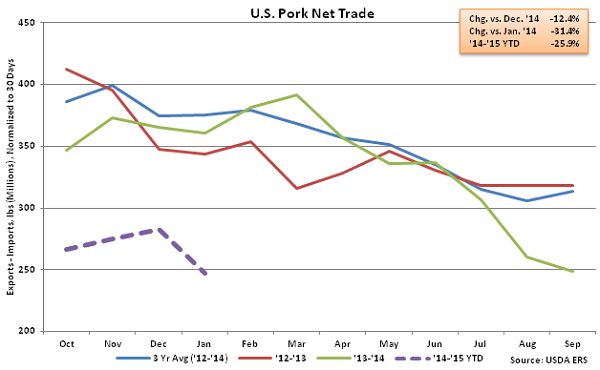 U.S. pork export volumes have strengthened considerably over the past 25 years, increasing at a compound annual growth rate (CAGR) of 13.2%, while U.S. pork imports have remained fairly flat, increasing at a CAGR of 0.3% over the same time period. ’13-’14 annual pork imports experienced much stronger growth, finishing 10.5% higher than the previous year, the largest YOY percentage gain in 11 years. Despite the increase in pork imports, ’13-’14 annual pork exports volumes remained over five times as large as import volumes.
U.S. pork export volumes have strengthened considerably over the past 25 years, increasing at a compound annual growth rate (CAGR) of 13.2%, while U.S. pork imports have remained fairly flat, increasing at a CAGR of 0.3% over the same time period. ’13-’14 annual pork imports experienced much stronger growth, finishing 10.5% higher than the previous year, the largest YOY percentage gain in 11 years. Despite the increase in pork imports, ’13-’14 annual pork exports volumes remained over five times as large as import volumes.
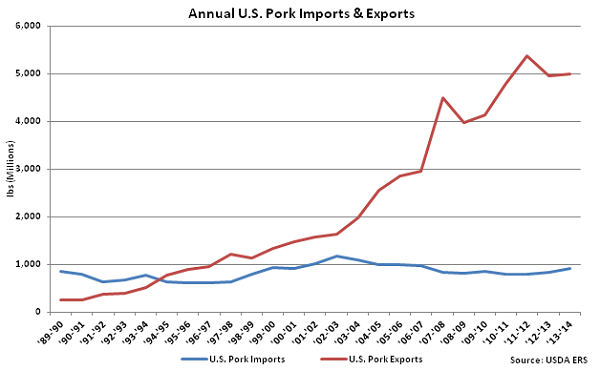 Beef & Veal – Net Trade Declines to Seven and a Half Year Low
Jan ’15 U.S. beef & veal export volumes declined 19.3% YOY and 23.3% MOM on a daily average basis to a five year low. YOY declines in U.S. beef & veal export volumes were widespread across major import destinations. Volumes to South Korea declined 28.3%, combined volumes to Hong Kong, Taiwan and China declined by 26.3%, volumes to Canada declined 23.6%, volumes to Japan declined 15.4% and volumes to Mexico declined by 10.7%. U.S. beef & veal exports to the aforementioned countries accounted for over 85% of all beef & veal export volumes in Jan ’15.
Jan ’15 U.S. beef & veal imports remained strong, increasing 63.7% YOY and 3.3% MOM on a daily average basis to a seven and a half year high. Beef & veal import volumes exceeded export volumes for the 11th consecutive month in Jan ’15, with import volumes exceeding export volumes by 22.9% over the period.
Beef & Veal – Net Trade Declines to Seven and a Half Year Low
Jan ’15 U.S. beef & veal export volumes declined 19.3% YOY and 23.3% MOM on a daily average basis to a five year low. YOY declines in U.S. beef & veal export volumes were widespread across major import destinations. Volumes to South Korea declined 28.3%, combined volumes to Hong Kong, Taiwan and China declined by 26.3%, volumes to Canada declined 23.6%, volumes to Japan declined 15.4% and volumes to Mexico declined by 10.7%. U.S. beef & veal exports to the aforementioned countries accounted for over 85% of all beef & veal export volumes in Jan ’15.
Jan ’15 U.S. beef & veal imports remained strong, increasing 63.7% YOY and 3.3% MOM on a daily average basis to a seven and a half year high. Beef & veal import volumes exceeded export volumes for the 11th consecutive month in Jan ’15, with import volumes exceeding export volumes by 22.9% over the period.
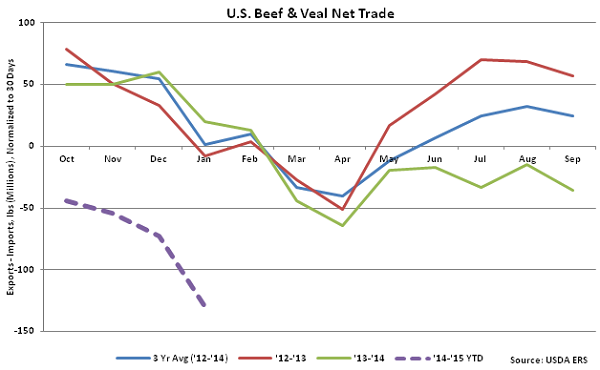 Recent strength in beef & veal imports resulted in ’13-’14 annual U.S. beef & veal imports finishing higher than annual U.S. beef & veal exports for the first time in four years. This trend has continued into the ’14-’15 production season, with December net trade being the lowest in seven and a half years.
Recent strength in beef & veal imports resulted in ’13-’14 annual U.S. beef & veal imports finishing higher than annual U.S. beef & veal exports for the first time in four years. This trend has continued into the ’14-’15 production season, with December net trade being the lowest in seven and a half years.
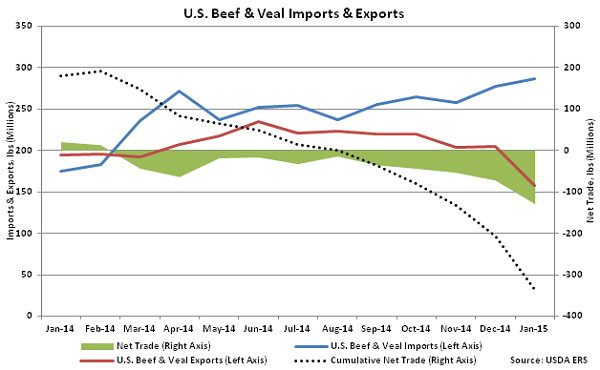 Chicken – Net Trade Declines to Two Year Low
Jan ’15 U.S. broiler export volumes declined 12.4% YOY and 5.9% MOM on a daily average basis to a two year low. Monthly export volumes have declined YOY for four consecutive months as the broiler export market continues to be negatively affected by the Russian import ban. Russia accounted for 8.2% of U.S. broiler export volumes throughout the ’12-’13 production season. Excluding Russia, broiler export volumes remained lower, but by only 5.1%. U.S. broiler export volumes to Mexico remained strong, increasing on a YOY basis for the 13th consecutive month and finishing up 2.2% YOY. Broiler export volumes to Mexico have accounted for over a fifth of total broiler export volumes over the past 12 months.
Jan ’15 U.S. broiler imports declined 16.4% YOY and 20.9% MOM on a daily average basis. Broiler imports remain at insignificant levels relative to export volumes, with Jan ’15 imports amounting to only 1.6% of export volumes. Jan ’15 net broiler trade was down 12.3% YOY and 5.6% MOM on a daily average basis to the lowest level in two years. The Jan ’15 monthly YOY decline in net trade was the largest in nearly five years.
Chicken – Net Trade Declines to Two Year Low
Jan ’15 U.S. broiler export volumes declined 12.4% YOY and 5.9% MOM on a daily average basis to a two year low. Monthly export volumes have declined YOY for four consecutive months as the broiler export market continues to be negatively affected by the Russian import ban. Russia accounted for 8.2% of U.S. broiler export volumes throughout the ’12-’13 production season. Excluding Russia, broiler export volumes remained lower, but by only 5.1%. U.S. broiler export volumes to Mexico remained strong, increasing on a YOY basis for the 13th consecutive month and finishing up 2.2% YOY. Broiler export volumes to Mexico have accounted for over a fifth of total broiler export volumes over the past 12 months.
Jan ’15 U.S. broiler imports declined 16.4% YOY and 20.9% MOM on a daily average basis. Broiler imports remain at insignificant levels relative to export volumes, with Jan ’15 imports amounting to only 1.6% of export volumes. Jan ’15 net broiler trade was down 12.3% YOY and 5.6% MOM on a daily average basis to the lowest level in two years. The Jan ’15 monthly YOY decline in net trade was the largest in nearly five years.
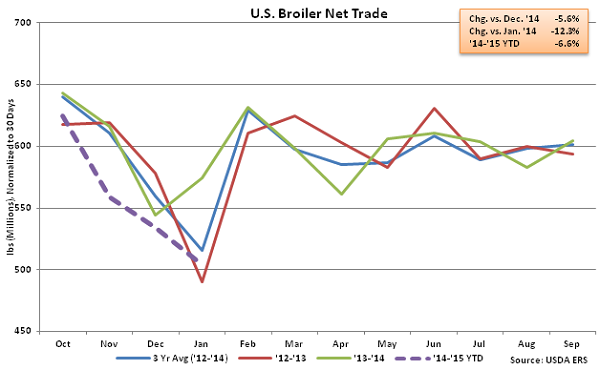 U.S. broiler export volumes have strengthened considerably over the past 25 years, increasing at a compound annual growth rate (CAGR) of 18.3%. U.S. broiler import volumes have increased at a CAGR of 21.6% over the same time period but remain significantly lower. ’13-’14 annual broiler exports volumes were over 60 times as large as import volumes.
U.S. broiler export volumes have strengthened considerably over the past 25 years, increasing at a compound annual growth rate (CAGR) of 18.3%. U.S. broiler import volumes have increased at a CAGR of 21.6% over the same time period but remain significantly lower. ’13-’14 annual broiler exports volumes were over 60 times as large as import volumes.
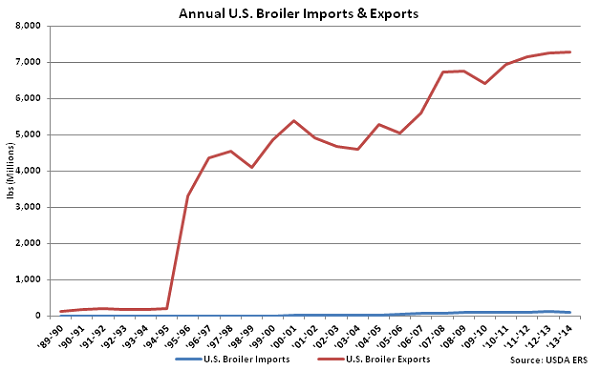
 U.S. pork export volumes have strengthened considerably over the past 25 years, increasing at a compound annual growth rate (CAGR) of 13.2%, while U.S. pork imports have remained fairly flat, increasing at a CAGR of 0.3% over the same time period. ’13-’14 annual pork imports experienced much stronger growth, finishing 10.5% higher than the previous year, the largest YOY percentage gain in 11 years. Despite the increase in pork imports, ’13-’14 annual pork exports volumes remained over five times as large as import volumes.
U.S. pork export volumes have strengthened considerably over the past 25 years, increasing at a compound annual growth rate (CAGR) of 13.2%, while U.S. pork imports have remained fairly flat, increasing at a CAGR of 0.3% over the same time period. ’13-’14 annual pork imports experienced much stronger growth, finishing 10.5% higher than the previous year, the largest YOY percentage gain in 11 years. Despite the increase in pork imports, ’13-’14 annual pork exports volumes remained over five times as large as import volumes.
 Beef & Veal – Net Trade Declines to Seven and a Half Year Low
Jan ’15 U.S. beef & veal export volumes declined 19.3% YOY and 23.3% MOM on a daily average basis to a five year low. YOY declines in U.S. beef & veal export volumes were widespread across major import destinations. Volumes to South Korea declined 28.3%, combined volumes to Hong Kong, Taiwan and China declined by 26.3%, volumes to Canada declined 23.6%, volumes to Japan declined 15.4% and volumes to Mexico declined by 10.7%. U.S. beef & veal exports to the aforementioned countries accounted for over 85% of all beef & veal export volumes in Jan ’15.
Jan ’15 U.S. beef & veal imports remained strong, increasing 63.7% YOY and 3.3% MOM on a daily average basis to a seven and a half year high. Beef & veal import volumes exceeded export volumes for the 11th consecutive month in Jan ’15, with import volumes exceeding export volumes by 22.9% over the period.
Beef & Veal – Net Trade Declines to Seven and a Half Year Low
Jan ’15 U.S. beef & veal export volumes declined 19.3% YOY and 23.3% MOM on a daily average basis to a five year low. YOY declines in U.S. beef & veal export volumes were widespread across major import destinations. Volumes to South Korea declined 28.3%, combined volumes to Hong Kong, Taiwan and China declined by 26.3%, volumes to Canada declined 23.6%, volumes to Japan declined 15.4% and volumes to Mexico declined by 10.7%. U.S. beef & veal exports to the aforementioned countries accounted for over 85% of all beef & veal export volumes in Jan ’15.
Jan ’15 U.S. beef & veal imports remained strong, increasing 63.7% YOY and 3.3% MOM on a daily average basis to a seven and a half year high. Beef & veal import volumes exceeded export volumes for the 11th consecutive month in Jan ’15, with import volumes exceeding export volumes by 22.9% over the period.
 Recent strength in beef & veal imports resulted in ’13-’14 annual U.S. beef & veal imports finishing higher than annual U.S. beef & veal exports for the first time in four years. This trend has continued into the ’14-’15 production season, with December net trade being the lowest in seven and a half years.
Recent strength in beef & veal imports resulted in ’13-’14 annual U.S. beef & veal imports finishing higher than annual U.S. beef & veal exports for the first time in four years. This trend has continued into the ’14-’15 production season, with December net trade being the lowest in seven and a half years.
 Chicken – Net Trade Declines to Two Year Low
Jan ’15 U.S. broiler export volumes declined 12.4% YOY and 5.9% MOM on a daily average basis to a two year low. Monthly export volumes have declined YOY for four consecutive months as the broiler export market continues to be negatively affected by the Russian import ban. Russia accounted for 8.2% of U.S. broiler export volumes throughout the ’12-’13 production season. Excluding Russia, broiler export volumes remained lower, but by only 5.1%. U.S. broiler export volumes to Mexico remained strong, increasing on a YOY basis for the 13th consecutive month and finishing up 2.2% YOY. Broiler export volumes to Mexico have accounted for over a fifth of total broiler export volumes over the past 12 months.
Jan ’15 U.S. broiler imports declined 16.4% YOY and 20.9% MOM on a daily average basis. Broiler imports remain at insignificant levels relative to export volumes, with Jan ’15 imports amounting to only 1.6% of export volumes. Jan ’15 net broiler trade was down 12.3% YOY and 5.6% MOM on a daily average basis to the lowest level in two years. The Jan ’15 monthly YOY decline in net trade was the largest in nearly five years.
Chicken – Net Trade Declines to Two Year Low
Jan ’15 U.S. broiler export volumes declined 12.4% YOY and 5.9% MOM on a daily average basis to a two year low. Monthly export volumes have declined YOY for four consecutive months as the broiler export market continues to be negatively affected by the Russian import ban. Russia accounted for 8.2% of U.S. broiler export volumes throughout the ’12-’13 production season. Excluding Russia, broiler export volumes remained lower, but by only 5.1%. U.S. broiler export volumes to Mexico remained strong, increasing on a YOY basis for the 13th consecutive month and finishing up 2.2% YOY. Broiler export volumes to Mexico have accounted for over a fifth of total broiler export volumes over the past 12 months.
Jan ’15 U.S. broiler imports declined 16.4% YOY and 20.9% MOM on a daily average basis. Broiler imports remain at insignificant levels relative to export volumes, with Jan ’15 imports amounting to only 1.6% of export volumes. Jan ’15 net broiler trade was down 12.3% YOY and 5.6% MOM on a daily average basis to the lowest level in two years. The Jan ’15 monthly YOY decline in net trade was the largest in nearly five years.
 U.S. broiler export volumes have strengthened considerably over the past 25 years, increasing at a compound annual growth rate (CAGR) of 18.3%. U.S. broiler import volumes have increased at a CAGR of 21.6% over the same time period but remain significantly lower. ’13-’14 annual broiler exports volumes were over 60 times as large as import volumes.
U.S. broiler export volumes have strengthened considerably over the past 25 years, increasing at a compound annual growth rate (CAGR) of 18.3%. U.S. broiler import volumes have increased at a CAGR of 21.6% over the same time period but remain significantly lower. ’13-’14 annual broiler exports volumes were over 60 times as large as import volumes.
